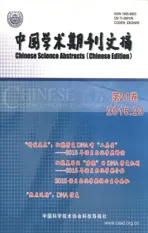DNA修复
2015-02-27
Shen, MR; Jones, IM; Mohrenweiser, H; et al.
Variation in DNA repair is a factor in cancer susceptibility: A paradigm for the promises and perils of individual and population risk estimation?
Mohrenweiser, HW; Jones, IM
Polymorphisms of DNA repair geneXRCC1in squamous cell carcinoma of the head and neck
Sturgis, EM; Castillo, EJ; Li, L; et al.
DNA损伤修复基本方式的研究进展
朱守民,夏昭林
(复旦大学公共卫生学院劳动卫生学教研室,上海 200032)
螺旋藻多糖对核酸内切酶活性和DNA修复合成的增强作用
庞启深,郭宝江,阮继红
热点追踪
DNA修复
·编者按·
DNA修复(DNA repair)是细胞对DNA受损伤后的一种反应,这种反应可能使DNA结构恢复原样,重新执行它原来的功能;但有时并非能完全消除DNA的损伤,只是使细胞能够耐受DNA的损伤而能继续生存。也许这未能完全修复而存留下来的损伤会在适合的条件下显示出来(如细胞的癌变等),但如果细胞不具备这修复功能,就无法对付经常发生的DNA损伤事件,甚至不能生存。DNA持续受到来自环境的攻击,但它们的结构完整程度却出人意料。托马斯·林达尔(Tomas Lindahl)、保罗·莫德里奇(Paul Modrich)以及阿齐兹·桑贾尔(Aziz Sancar)因为描述并解释了细胞修复DNA的机制以及对遗传信息的保护措施,而被授予了2015年的诺贝尔化学奖。
DNA损伤可分为内源性损伤(endogenous)和外源性损伤(exogenous)两大类型。其中,内源性损伤一般是指被正常代谢的副产物活性氧分子(自由基)攻击导致的损伤(自发突变);外源性损伤则是由外部因素引起的损伤,这些外部因素包括来自太阳的紫外射线(UV 200~300 nm)、其他频率的辐射、水解和热解、某些植物毒素、人造的突变物质以及肿瘤的化学疗法和放射线疗法等。
由于DNA损害来源无法避免,细胞就必须对这些DNA损害的形式采取适当的措施。对一个细胞来说,消极的做法是暂时容忍损害的存在,等到细胞的基因体受损到一定程度,细胞自然无法再持续进行运作;而积极的做法则是针对所有可能的DNA损害发展出相对应的修复补救措施,以确保基因体内遗传讯息的正确性。根据分子生物学近几年来的研究发展,科学家已经发现从以单细胞形式存活的酵母菌到人类的细胞,都可以找到相对应的DNA修复机制,这说明DNA修复机制在各物种间的高度保守性,更充分显示了DNA损害所造成的危害,在生物演化初期就无可避免。
在现存细胞内的DNA修复机制中,由DNA损害断裂的程度可以分为两种类型,一种是单链损害,另一种则是DNA双链断裂。前者修复机制通常需要借助其对应的另一条DNA链当模板,而后者在缺乏另一条DNA序列当模板的情况下,则是转而透过同源的染色体序列或姊妹染色单体来寻求支持。在高等生物中,有时候DNA双链断裂的修复有可能无须任何序列当模板,而径行将断裂部分直接接合,然而这种DNA修复方式可能隐含错误的机率。DNA损伤修复的3种基本方式分别是碱基切除修复(base excision repair,BER)、核苷酸切除修复(nucleotide excision repair,NER)和错配修复(mismatch repair,MMR)。
研究DNA修复也是探索生命的一个重要方面,在军事医学、肿瘤学等研究中有着广泛的应用前景。
本专题得到了黄德军副教授(兰州大学生命科学学院)的大力支持。
·热点数据排行·
截至2015年10月20日,中国知网(CNKI)和Web of Science(WOS)的数据报告显示,以“DNA修复”为词条检索到的期刊文献分别为1075与7648条,本专题将相关数据按照:研究机构发文数、作者发文数、期刊发文数、被引用频次进行排行,结果如下。
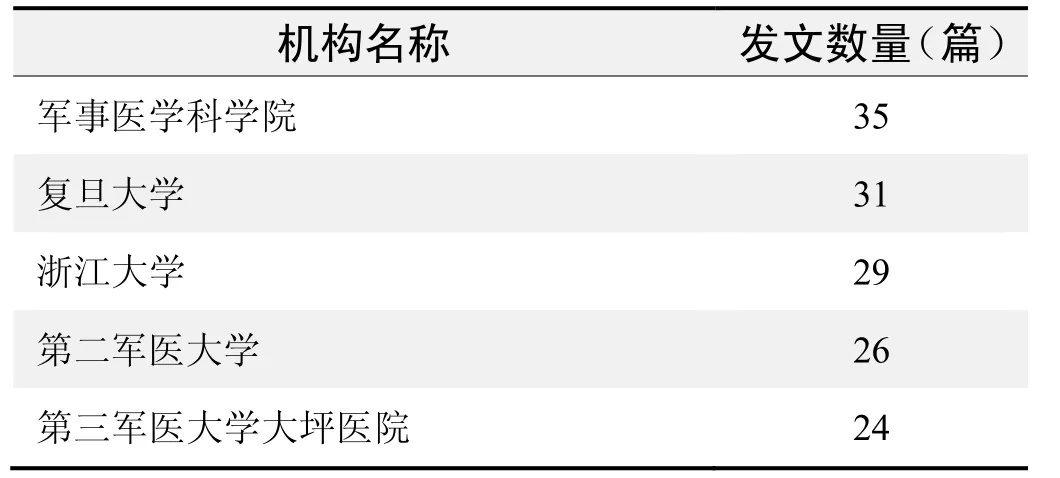
研究机构发文数量排名(CNKI)
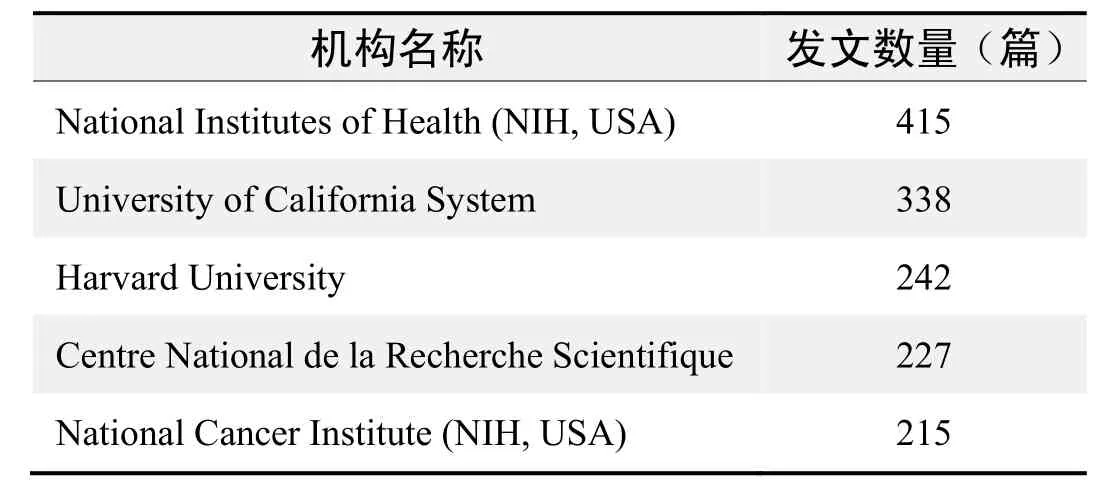
研究机构发文数量排名(WOS)

作者发文数量排名(CNKI)
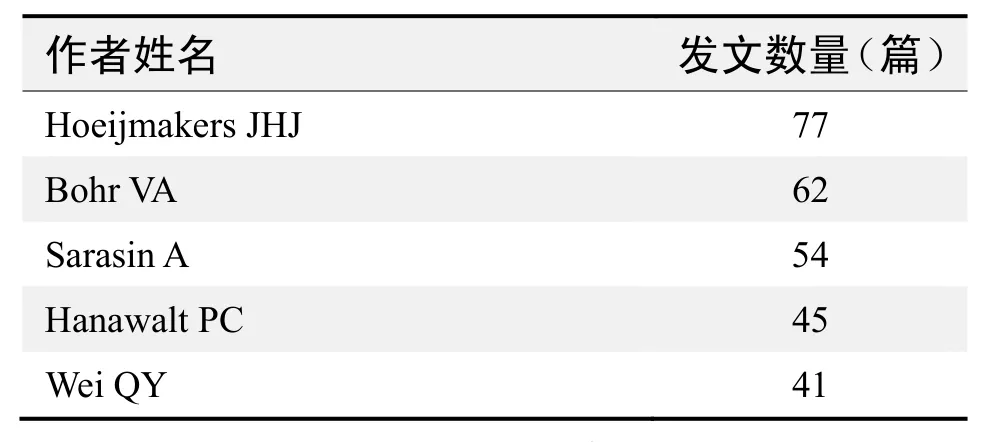
作者发文数量排名(WOS)
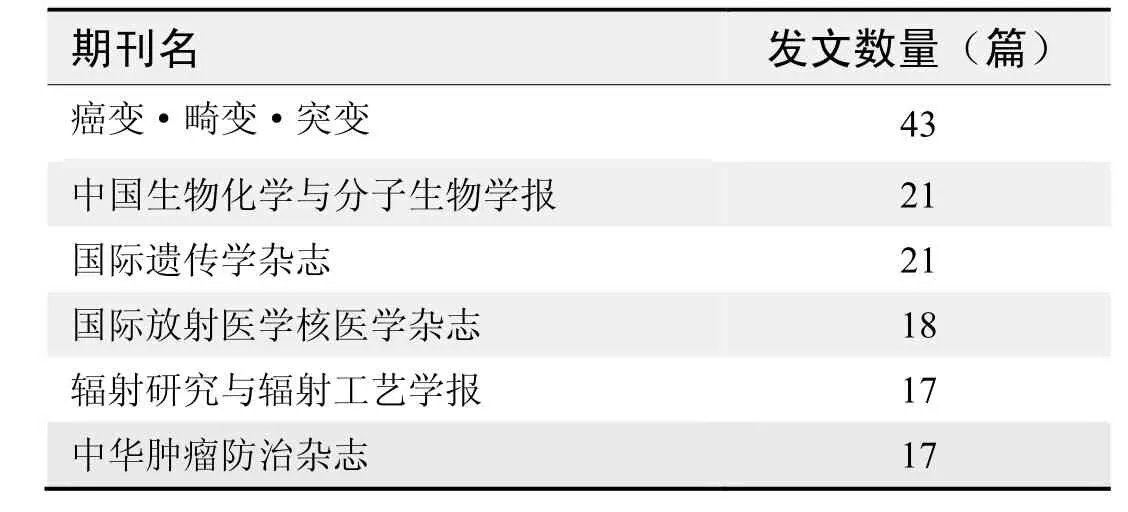
期刊发文数量排名(CNKI)
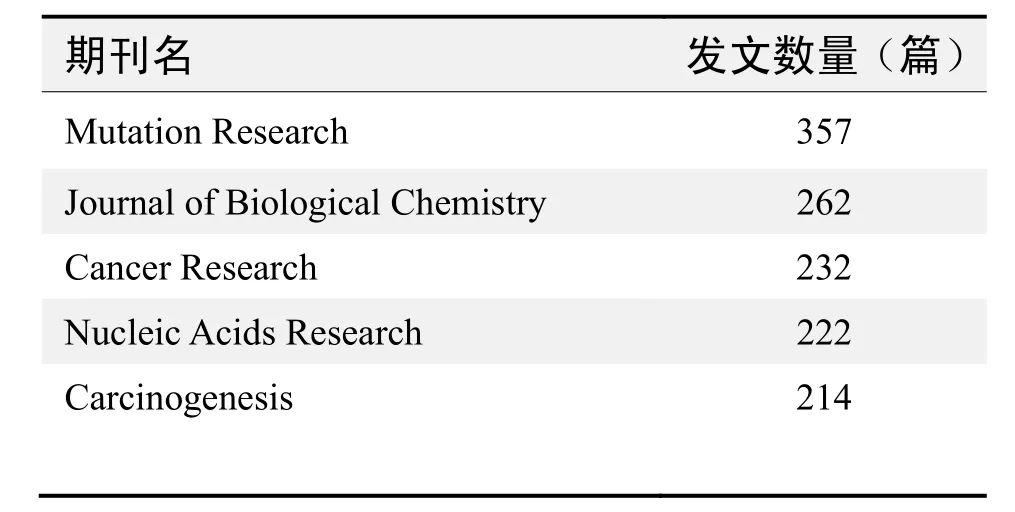
期刊发文数量排名(WOS)
根据中国知网(CNKI)数据报告,以“DNA修复”为词条检索到的高被引论文排行结果如下。

国内数据库高被引论文排行
根据Web of Science统计数据,以“DNA修复”为词条检索到的高被引论文排行结果如下。
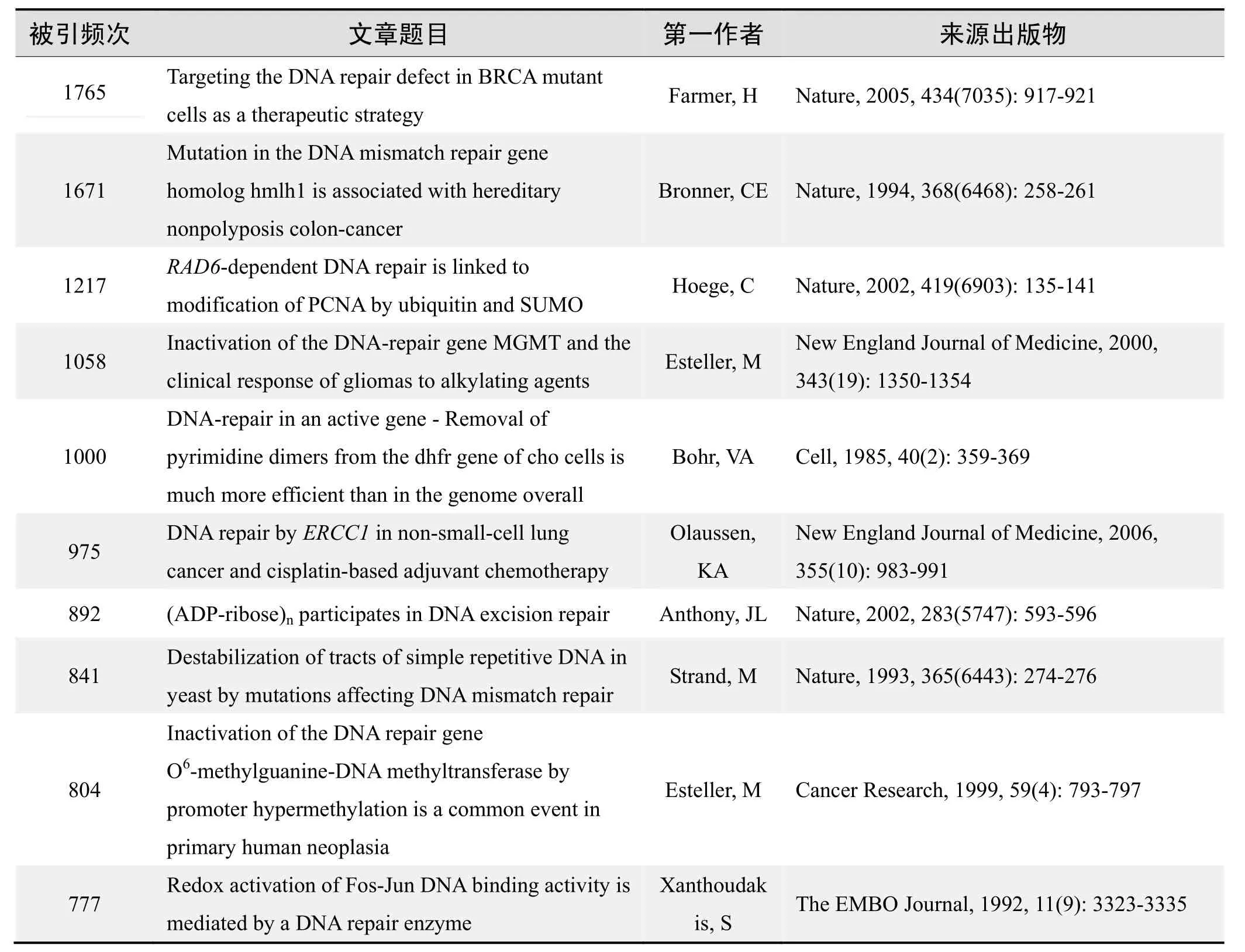
国外数据库高被引论文排行
·经典文献推荐·
基于Web of Science检索结果,利用Histcite软件选取LCS(Local Citation Score,本地引用次数)TOP 30文献作为节点进行分析,得到本领域推荐的经典文献如下。
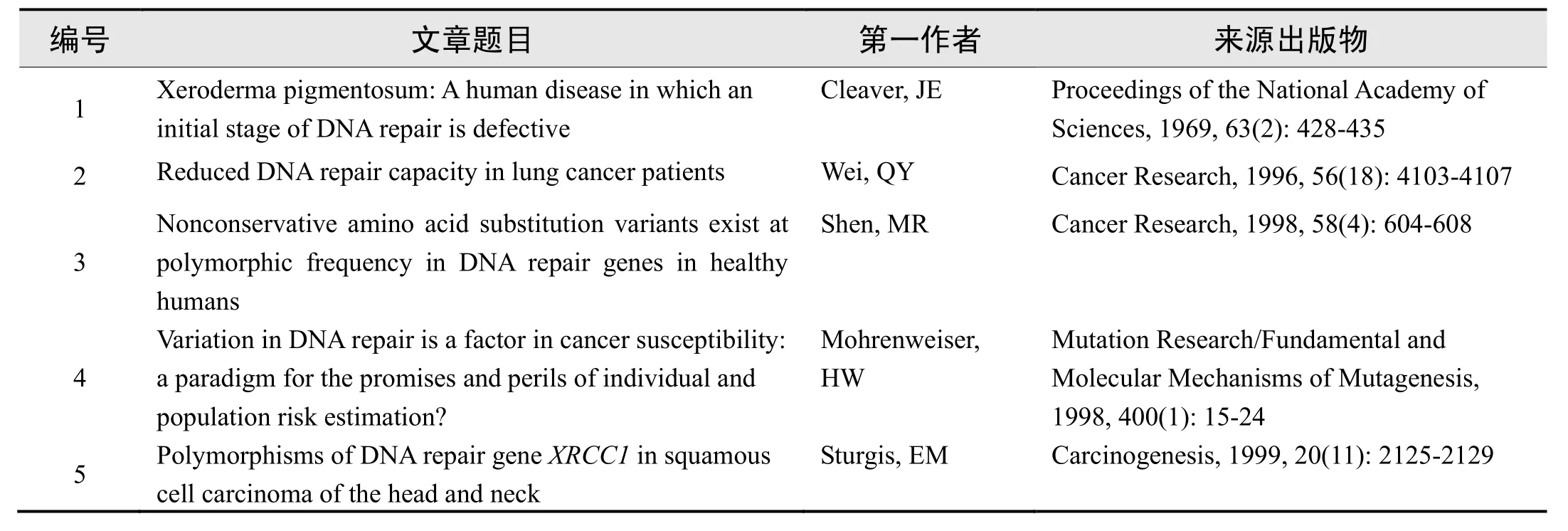
本领域经典文献
来源出版物:Cancer Research, 1996, 56(18): 4103-4107
Nonconservative amino acid substitution variants exist at polymorphic frequency in DNA repair genes in healthy humans
Shen, MR; Jones, IM; Mohrenweiser, H; et al.
Abstract:The removal or repair of DNA damage has a key role in protecting the genome of the cell from the insults of cancer-causingagents, This was originally demonstrated in individuals with the rare genetic disease xeroderma pigmentosum, the paradigm of cancer genes, and subsequently in the relationship between mismatch repair and colon cancer, Recent reports suggest that individuals with less dramatic reductions in the capacity to repair DNA damage are observed at polymorphic frequency in the population; these individuals have an increased susceptibility to breast, lung, and skin cancer. We report initial results from a study to estimate the extent of DNA sequence variation among individuals in genes encoding proteins of the DNA repair pathways, Nine different amino acid substitution variants have been identified in resequencing of the exons of three nucleotide excision repair genes (ERCC1,XPD, andXPF), a gene involved in double-strand break repair/recombination genes (XRCC3), and a gene functioning in base excision repair and the repair of radiation-induced damage (XRCC1), The frequencies for the nine different variant alleles range from 0.04 to 0.45 in a group of 12 healthy individuals; the average allele frequency is 0.17, The potential that this variation, and especially the six nonconservative amino acid substitutions occurring at residues that are identical in human and mouse, may cause reductions in DNA repair capacity or the fidelity of DNA repair is intriguing; the role of the variants as cancer risk factors or susceptibility alleles remains to be addressed.
来源出版物:Cancer Research, 1998, 58(4): 604-608
Variation in DNA repair is a factor in cancer susceptibility: A paradigm for the promises and perils of individual and population risk estimation?
Mohrenweiser, HW; Jones, IM
Abstract:The repair of DNA damage protects the genome of the cell from the insults of cancer causing agents. This was originally demonstrated in individuals with the rare genetic disease, xeroderma pigmentosum, the prototype of cancer genes, and subsequently in the relationship of mismatch repair to colon cancer. Recent studies suggest that individuals with less dramatic reductions in the capacity to repair DNA damage are observed at polymorphic frequency and these individuals have an increased susceptibility to several types of cancer. Screening of individuals for DNA sequence variation in the exons of 9 DNA repair genes has resulted in identification of 15 different polymorphic amino acid substitution variants. Although the studies to relate these variants to reduced DNA repair capacity and cancer status have not been completed, the available information is sufficient to suggest that DNA repair genes should be incorporated into molecular epidemiology and cancer susceptibility studies. The availability of molecular epidemiology data presents exciting opportunities for refinement of risk estimation models and identification of individuals at increased risk of disease, with resultant opportunities for effective surveillance and early intervention and treatment. The opportunities to acquire susceptibility data are associated with possible perils for establishment of regulations for permissible exposures to carcinogenic agents and also stigmatization of 'at risk' individuals that may result in decreased access to employment opportunities and health care.
来源出版物:Mutation Research/Fundamental and Molecular Mechanisms of Mutagenesis, 1998, 400(1): 15-24
Polymorphisms of DNA repair geneXRCC1in squamous cell carcinoma of the head and neck
Sturgis, EM; Castillo, EJ; Li, L; et al.
Abstract:Because reduced DNA repair capacity (phenotype) has been suggested as a risk factor for squamous cell carcinoma of the head and neck (SCCHN), newly-identified DNA repair gene polymorphisms (genotype) may also be implicated in risk. To test this hypothesis, we conducted a case-control study of 203 SCCHN patients and 424 control subjects (matched for age, sex and ethnicity) to investigate the role of twoXRCC1polymorphisms (XRCC126304 T andXRCC128152 A, respectively) in SCCHN. Multivariate logistic regression analysis was performed to calculate the adjusted odds ratio (OR) and 95% confidence interval (CI), A total of 180 cases (88.7%) and 363 controls (85.6%) lacked theXRCC126304 T allele [adjusted OR=1.34 (CI, 0.80-2.25)]. Lack of this polymorphism was a significant risk factor specifically for cancers of the oral cavity and pharynx [adjusted OR=2.46 (CI, 1.22-4.97)]. Thirty-two cases (15.8%) and 46 controls (10.8%) were homozygous for theXRCC128152 A allele [adjusted OR=1.59 (CI, 0.97-2.61) for all cases, and 1.41 (CI, 0.80-2.48) for oral and pharyngeal cancer only]. Furthermore, when the two genotypes were combined into a three-level model of risk, a polymorphismpolymorphism interaction of increasing risk (trend test,P=0.049) was evident: OR=1.0 for those with neither risk genotype (referent group), adjusted OR=1.51 (CI, 0.87-2.61) for those with either risk genotype, and 2.02 (CI, 1.00-4.05) for those with both risk genotypes, For oral and pharyngeal cancer, this trend was even more pronounced with the adjusted OR=2.68 (CI, 1.28-5.61) for those with either risk genotype, and 3.22 (CI, 1.33-7.81) for those with both risk genotypes, The findings support the hypothesis that a polymorphicXRCC1DNA repair gene contributes to risk of developing SCCHN.
来源出版物:Carcinogenesis, 1999, 20(11): 2125-2129
·推荐综述·
DNA损伤修复基本方式的研究进展
朱守民,夏昭林
(复旦大学公共卫生学院劳动卫生学教研室,上海 200032)
1997年10月,美国国立环境卫生科学研究所(NIEHS)提出环境基因组计划,阐明基因和环境对疾病的影响和它们之间的相互作用,列举了11大类共76种再测序的环境应答基因,DNA修复基因被列为第一位,其中21种DNA修复酶基因被列为重点研究对象[1]。人类基因与其它物种的基因的功能均是编码遗传信息从而保护其完整性。DNA修复酶始终监视染色体并修复癌基因和细胞化学物所致的核苷酸残基的破坏,若没有DNA修复,那么由多种多样的DNA损伤因素所引起的染色体不稳定性将对细胞和生物体产生致命的影响。
本文分别阐述了DNA损伤修复3种基本方式,即碱基切除修复(base excision repair,BER)、核苷酸切除修复(nucleotide excision repair,NER)和错配修复(mismatch repair,MMR),并讨论DNA链断裂的重组和重接合修复及DNA聚合酶绕道修复DNA损伤。
1 碱基切除修复
碱基切除修复是指切除和替换由内源性化学物作用产生的DNA碱基损伤,DNA糖基化酶参与此过程,随后糖-磷酸键断裂,切去碱基残基,DNA链连接修复损伤。有3种不同的核DNA糖基化酶参与修复氧化作用产生的DNA损伤,还有1种主要切除烷基化嘌呤。已发现的DNA糖基化酶中的4种均可切除DNA上的尿嘧啶。尿嘧啶糖基化酶上的Ala被Tyr147取代,或Cys、Ser、Asn204取代Asp(外显子5),尿嘧啶糖基化酶转变为胞嘧啶糖基化酶或胸腺嘧啶糖基化酶,尿嘧啶糖基化酶选择性降低,可误切除去正常的嘧啶,出现突变型细胞[2],其中第3外显子点突变可导致编码子143错意突变,导致神经胶质瘤发生[3]。
O6-甲基鸟嘌呤-DNA甲基转移酶(O6-methylguanine-DNAmethy l transferase,MGMT)可同时发挥转移酶和甲基接受体的作用,是DNA损伤修复的重要的酶,将甲基从O6-甲基鸟嘌呤转移到自身的半胱氨酸残基上,使DNA链上的鸟嘌呤复原,同时自身不可逆的失活,目前还没有发现其它蛋白质参与此过程。它可切除甲基和其它小的烷基,对保护细胞免受烷化剂损害、防止细胞癌变和死亡起重要作用。神经胶质瘤的MGMT启动子甲基化可抑制其表达。由于MGMT存在于体内多个组织中,DNA烷基化损伤导致的致突变、致癌效应并没有组织特异性,当正常DNA修复功能变化时,人体内各种器官组织都有可能发生突变的积累,肿瘤的易感性升高[4]。已发现DNA修复基因表达变异如MGMT和MSH6是起源上渐成的。神经胶质瘤MGMT启动子甲基化抑制其表达,烷化剂治疗后表达增加。人类基因组研究使确定启动子区域成为可能,进而可研究CpG岛的DNA甲基化情况[3]。
X线修复交叉互补基团1(x-ray repair crosscomplementing group 1,XRCC1)和DNA聚合酶β、DNA连接酶Ⅲ相互作用,共同参与碱基切除修复。对XRCC1基团的分析显示,有3个会导致氨基酸发生变化的基因多态性分别发生在密码子194,280,399位[8],其中尤以399位值得引起重视,399位密码子位于PARP [poly (ADP-ribose) polymerase]的结合阈-BRCT-1上,而许多有BRCT阈的蛋白质参与细胞周期和DNA损伤修复[6]。有研究表明DNA修复能力和XRCC1399Arg-Gln基因表型的变化有关[7]。另外Arg194和399Arg-Gln多态与吸烟有交互作用,需进行流行病学调查和功能研究以确定XRCC1在肿瘤发生中的重要作用[8]。虽然报道了许多DNA修复基因的多态性,但因此出现的氨基酸改变的功能等信息却很少。发现确实影响蛋白质功能的多态,然后进行流行病学和临床研究是很重要的,例如特殊的多态纯合体的DNA连接酶亚单位XRCC1在吸烟者中姐妹染色体交换的频率较高,表明该等位基因对烟草和年龄等DNA损伤因素有较高的风险。需进一步拓展有关多态的生物作用的研究[9]。
许多生物体具光裂解酶,修复由紫外线诱导的环丁烷嘧啶二聚体和光产物等的损伤。人类基因组2个CRT基因具相同的光裂解酶序列,编码与生理节奏有关的蓝光受体而与DNA损伤修复无关。人类基因中没发现DNA光裂解酶的其它同源基因,这与以往认为脊椎动物包括鱼、爬行动物及有袋类哺乳动物广泛存在,而有胎盘的哺乳动物并不广泛存在光裂解酶是一致的。
2 核苷酸切除修复
核苷酸切除修复主要切除由环境因素作用产生的大的加合物。人有精密的核苷酸切除修复基因,它至少有4种核苷酸切除修复因子可连接DNA损伤位点,有两种切开链的DNA螺旋酶,切口则由核苷酸酶连接。
着色性干皮病基因C(xeroderma pigmentosum pomplementary group C,XPC)其等位基因XPC、XPC-PAT+突变,XPC-PAT+/-和XPC-PAT+/+基因型显著增加了患头颈部鳞状细胞癌的风险,DNA修复基因多态性可致其修复功能改变,故推测遗传性DNA修复基因多态性可增加癌症的遗传易感性[10]。暴露于内源性或外源性的致癌因素或遗传毒物可引起细胞周期延迟,影响细胞DNA损伤修复。XPC的内含子9与外显子15单核苷酸多态连接失衡,导致氨基酸改变,改变的XPC蛋白连接HR23B形成复合物,作用可能是激活NER损伤的早期识别因子[11]。另外发现XPC杂合子与纯合子相比,转录和蛋白表达没发现数量明显改变,提示存在可能的监视XPC蛋白表达水平的机制[12]。
着色性干皮病基因D(xeroderma pigmentosum complementary group D,XPD)是ATP依赖的5′→3′解旋酶,可编码核苷酸切除修复成分,可切除由香烟烟雾导致的DNA加合物,一个有关鳞状细胞癌的病例—对照研究表明,312和751位点多态可增加与吸烟有关的鳞状细胞肺癌的发病风险[13]。非西班牙裔白种美国人XPD的23047和23051位点的突变与头颈部鳞状细胞癌(SCCHN)无关,提示从复杂的修复过程中识别由单一基因的单一位点突变导致的DNA修复能力微弱的改变是很困难的,需进行重组过程的蛋白结构和体外功能研究。XPD参与核苷酸切除修复及P53介导的凋亡反应,其312和751位点具多态,研究表明312位点进化上高度保守,在维持XPD蛋白功能上起一定作用;而751Gln位于XPD蛋白的N端,保守性差,可作为反映DNA修复能力的指标[14]。
科凯恩综合征(Cockayne syndrome,CS)等位基因CSB 发生突变,导致单氨基酸改变,使C-端2/3蛋白质失活;缺乏CSB基因,不能修复UV照射导致的基因损伤,是科克因综合征发生的原因[15]。转录相关的修复过程已知与CSA、CSB 和XAB的产物有关,且转录链修复速度快于非转录链,但转录修复的机制还不很清楚,需进一步研究揭示参与的其它物质。
X线修复交叉互补基因(x-ray repair cross-complementing group 3,XRCC3)是Rad-51蛋白家族的成员。XRCC3 241位点多态导致表达氨基酸改变,影响DNA修复能力[16]。其外显子7(18067位点)T等位基因与黑色素瘤的发生明显相关[17],此基因编码参与双链DNA同源重组修复,可修复染色体断裂、异位和缺失,在抑制UV诱导的肿瘤的发生过程起一定作用。
3 错配修复
错配修复可校正DNA复制和重组过程中非同源染色体偶尔出现的DNA碱基错配。错配的碱基可被错配修复酶识别后进行修复,人DNA链识别基因定位于DNA复制复合物或是其它未了解的因子,DNA双键断裂可能通过同源或非同源重组的方式修复。实验证实MMR缺失的细胞对烷基化化疗药物有较高的耐受性。
遗传性非息肉型结肠癌(hereditary nonpolyposis colorectal cancer,HNPCC),与DNA的错配修复基因突变有关,特别是hMSH2和hMLH1基因易发生突变[18],HNPCC患者MMR基因hMSH2、hMSH1、pMSH1和pMSH2遗传缺陷,使结肠癌潜伏期缩短为3~5年,而正常人为20~30年。hMSH2的5′端大约4.4 kb内富含CpG岛,并有许多参与表达的成分,但在转录起始位点附近没有TATA盒,为许多看家基因启动子典型结构。缺失分析发现少于300 bp的碱基足以引发转录,该区聚集Alu序列和单核苷酸重复序列,并有两个转录起始位点。此区域内发现一个多态位点,虽然没发现此区域多态影响启动子功能,但可作为检测等位基因缺失的标志[19]。
DNA双键断裂可能通过同源或非同源重组的方式修复。值得注意的是,人类至少有7种编码蛋白质的基因[1]。人类细胞同源重组可能包括分枝转移酶和分解酶,后者与细菌RuvABC系统功能相似。近来的生化实验支持分枝转移和分解酶的存在,但仍未发现相应的基因产物。
4 其他
对不同人群进行的研究显示,不同位点的基因表型的分布存在种族和地区的差异,提示遗传差异性的存在及基因和环境的相互作用,值得进一步研究[20]。DNA修复系统在维持机体的遗传稳定性方面起关键作用,它可以逆转由机体内外环境因素所致的DNA突变。一些修复基因的某些位点的多态性会导致DNA修复能力的改变,致使某些疾病发生的危险性增加。DNA修复基因是一类易感性基因,其多态性为人群中普遍存在的现象,对人群中肿瘤发生的影响较大。XRCC1、XRCC3、XPD是3种常见的DNA修复基因,分别参与不同的DNA修复途径,在一定程度上可反映机体的DNA修复能力,但仅仅单一基因的点突变不能决定吸烟者的肺癌易感性[16]。
人类基因组研究发现许多以前未识别的DNA聚合酶。人类现在至少有15种DNA聚合酶,多于其它物种[1]。修复核DNA时,BER主要使用的酶为Polβ而NER和MMR分别为Polδ和Polε。遗传与生化研究阐明了新发现的聚合酶在DNA损伤时的功能。随着新的生化分析方法应用于修复研究的不同方面,将发现新基因例如可修复两条DNA链间交联的新的基因。天然化学物及用于癌症治疗的药物以及电磁和紫外辐射均可导致链内交联,修复这种交联需NER基因和与重组有关的XRCC2和XRCC3,并猜测DNA聚合酶POLQ也参与其中,另外对范科尼贫血个体(FA)敏感细胞的研究指出,FANC基因组在交换修复中起一定的作用。但链内交联修复机制仍不清楚[3]。
目前注意力多集中于探明细胞损伤信号传递到细胞周期检查点的机制和控制细胞凋亡的监视系统的研究。近来研究这一复杂的网络已取得了一定的进展,它包括损伤识别因子、蛋白激酶、转录因子如p53[21]。已经尝试获取DNA修复组成图中起信号作用的部分,这是一个令人感兴趣的方向,一些人类遗传病由于缺乏与损伤识别有关的功能(如ATM)而对DNA损伤因素敏感。
·高被引论文摘要·
被引频次:101
螺旋藻多糖对核酸内切酶活性和DNA修复合成的增强作用
庞启深,郭宝江,阮继红
本文用核酸内切酶实验和放射自显影术研究了螺旋藻水溶性多糖对DNA切除修复的效应。结果表明,该多糖能显著增强辐射引起DNA损伤的切除修复活性和程序外DNA合成(UDS)。考察切除修复的时程,发现螺旋藻多糖的存在不但能加快损伤DNA切除反应和UDS的初时速度,而且能延缓以上两个重要修复反应的饱和。
螺旋藻;多糖;内切酶活性;DNA修复合成
来源出版物:遗传学报, 1988, 15(5): 374-374
被引频次:86
北京地区汉族人群DNA修复基因XPD单核苷酸多态性与肺癌及食管癌风险的研究
邢德印,齐军,谭文,等
摘要:功能化DNA修复氯化1-(2-羟乙基)-3-甲基咪唑盐是纤维素的新型良溶剂,在70℃时微晶纤维素的溶解能力达到5%~7%。向DNA修复纤维素溶液中加入去离子水可获得再生纤维素。用XRD,FT-IR和TGA对再生纤维素进行了表征,IR和XRD数据表明,功能化DNA修复是纤维素的直接溶剂,但TGA数据则表明再生纤维素的热稳定性有所降低,热失重残留物有所增加。对溶解机理进行了初步讨论。
关键词:肺癌;食管癌;XPD基因;遗传多态性
来源出版物:中华医学遗传学杂志, 2003, 20(1): 35-38
被引频次:85
中国人DNA修复基因XRCC1单核苷酸多态及其与食管癌风险的关系
宋春英,谭文,林东昕
摘要:目的:研究碱基切除修复基因XRCC1单核苷酸多态与食管癌易感性的关系。方法:以PCR-RFLP方法分析了食管癌病例(n=222)和按性别、年龄频数配对的正常对照者(n=433)XRCC1基因C26304T和G28152A多态,并比较不同基因型与食管癌风险的关系以及基因多态与吸烟之间的交互作用对食管癌风险的影响。结果:在食管癌病人中XRCC126304TT变异基因型频率为12.6%,高于对照组的6.7%(P<0.05);携带此种基因型个体发生食管癌的风险比携带其他基因型者高1.8倍(校正的OR=1.83,95%CI1.03~3.24)。G28152A基因型频率在对照组和病例组中的分布无显著性差异(P>0.05),因而与食管癌风险无关。XRCC1基因这两个位点多态之间没有联合作用,但26304TT基因型与吸烟之间有一定的协同作用,在吸烟与否和吸烟量两个层次,26304TT基因型均与之有联合作用而增高食管癌风险。结论:DNA碱基切除修复基因XRCC1多态可能在食管癌的发生过程中起一定作用。
关键词:XRCC1基因;DNA修复;食管肿瘤;基因多态;分子流行病学
来源出版物:癌症, 2001, 20(1): 28-31
被引频次:84
甘草甜素抑制致癌过程中对DNA损伤修复的影响
严瑞琪,李俊丽,黄玫玲,等
摘要:本文检测外周淋巴细胞非程序DNA合成(UDS),探讨甘草甜素(GL)在抑制二乙基亚硝胺(DEN)致肝癌前病变发生过程中,对DNA损伤修复的影响。结果显示:大鼠腹腔注射DEN(100 mg/kg)后5小时,UDS值(168.5±36.5cpm/5×105LC)显著低于正常大鼠(226.7±47.0)(P<0.05);在加用GL的影响下,UDS值(212.3±69.2)显著提高,与正常者相接近(P>0.05)。在注射DEN后4周,肝癌前病变的发生受到GL抑制,同时UDS值(501.0±140.0)也显著高于不用GL者(367.0±36.3)(P<0.01),而与正常者(606.8±83.85)无明显差别(P>0.05)。提示GL抑制DEN致肝癌作用与GL保护DNA损伤修复有关。
关键词:甘草甜素;二乙基亚硝胺(DEN);非程序DNA合成
来源出版物:癌症: 英文版, 1995, 14(4): 245-248
被引频次:81
增殖细胞核抗原(PCNA)的分子结构及其生物学功能研究进展
宋楠萌,桑建利,徐恒,等
摘要:增殖细胞核抗原(PCNA)是真核生物复制复合体的核心成分,具有特殊的环状三级结构。作为真核细胞DNA聚合酶δ的推动因子,与不同复制相关蛋白结合,协调DNA复制过程。同时PCNA还作为功能转换因子,通过不同调控方式与多种细胞因子作用,参与了DNA损伤修复、细胞周期调控及凋亡等许多重要的细胞事件。另外作为细胞增殖的指标,PCNA与肿瘤等细胞增殖性疾病的发生和发展存在相关性,因此在临床上对PCNA的深入研究有重要意义。文中就PCNA的“功能性”结构及其在不同细胞事件中的功能转换(Function Switch)进行简要综述。
关键词:PCNA功能转换;PCNA结合区域;细胞周期;DNA复制;DNA修复
来源出版物:自然科学进展, 2006, 16(10): 1201-1209
被引频次:80
乳宁冲剂对乳腺增生病神经内分泌免疫网络及淋巴细胞DNA修复功能调节作用的观察
阙华发,陈红风,陆德铭,等
摘要:目的:探讨乳宁冲剂治疗乳腺增生病临床疗效和作用机制,阐明乳腺增生病的发病机理。方法:对187例乳腺增生病患者分别采用乳宁冲剂(147例)和三苯氧胺(40例)治疗,疗程均为3个月,观察两组临床疗效及治疗前后神经递质、内分泌激素,T细胞亚群和淋巴细胞DNA损伤修复功能的变化。结果:乳腺增生病患者存在去甲肾上腺素(NE)、催乳素(PRL)、T辅助及诱导细胞(OKT4+)、T抑制或细胞毒细胞(OKT+8)异常升高(P<0.01),孕酮(P)、睾酮(T)、总T细胞(OKT+3)、OKT+4 /OKT+8、淋巴细胞DNA损伤修复能力(UDS)值明显低下(P<0.05,P<0.01),5 -色胺(5 -HT)、肾上腺素(E)、雌二醇(E2)、卵泡刺激素(FSH)、黄体生成素(LH)呈分泌紊乱状态,乳宁冲剂对此有明显的调整作用。通过与三苯氧胺组对比观察,结果显示乳宁冲剂组临床痊愈率优于三苯氧胺组(P<0.05),其调节5 -HT/NE、E2/P、T、OKT+3作用亦优于三苯氧胺组(P<0.05),并且在治疗过程中未发现明显毒副作用。结论:乳腺增生病的发生是以神经内分泌免疫网络功能失调或紊乱为中心的多因素共同作用的结果;乳宁冲剂治疗乳腺增生病有良好疗效的重要机制可能在于从整体上多环节、多途径、多层次的调整了失调或紊乱的神经内分泌免疫网络状态,提高了机体内环境的稳定能力。
关键词:乳腺增生病;神经内分泌免疫网络;DNA修复功能;乳宁冲剂
来源出版物:中国中西医结合杂志, 1999, 19(9): 529-532
被引频次:60
DNA修复基因XPD多态性和肝细胞肝癌危险性的病例-对照研究
许丽,吴一迁,金晏,等
摘要:目的:探讨DNA修复基因XPD多态性和肝细胞肝癌(Hepatocellular carcinoma,HCC)发生的关系。方法:应用病例-对照研究方法,选择了江苏启东地区72例HCC患者以及137例正常对照,以年龄(±3岁)和性别为配对因素进行了配对,对XPD-751位点基因多态性作PCR-RFLP分析。结果:XPD-751位点的Gln/Lys或Gln/Gln基因型的发生频率在病例组中明显高于对照组,差别有显著性(OR= 3.13,95%CI= 1.16~8.47),在调整了HBV感染因素后,差别的显著性虽然消失,但可信限下限位于临界处(OR= 2.70,95%CI= 0.98~7.42)。对HBV感染患者并同时伴有XPD-751位点为Gln/Lys或Gln/Gln基因型的个体,其HCC发生的危险性是HBV阴性及XPD-751位点为Lys/Lys野生型基因型个体的6.68倍,差别有显著性(OR= 6.68,95%CI=3.4313.01)。结论:本次研究的结果首次应用病例-对照研究发现XPD-751位点基因多态性可能影响HCC的发生,同时指出XPD-751位点基因多态性和HBV感染之间可能存在基因)环境交互作用。
关键词:肝肿瘤/流行病学;癌,肝细胞;病例-对照研究;DNA修复;XPD基因;遗传多态性
来源出版物:肿瘤, 2004, 24(6): 526-529
被引频次:60
DNA断裂检测方法——单细胞凝胶电泳法
秦椿华,沈建英,黄仕和,等
摘要:单细胞凝胶电泳(single cell gel electrophoresis assay, SCGE)也叫彗星试验(comet assay),是一种快速、敏感、简便、廉价的检测单个哺乳动物细胞DNA断裂的技术,目前已用于检测氧化、紫外线和电离辐射引起的损伤,以及三氯乙烷、丙烯酞胺等化学物及老化、吸烟所致损害的研究。文章介绍SCGE的发展、检测分析方法、原理及其在DNA损伤与修复、生物监测、遗传毒理研究、肿瘤治疗方案优化和疗效研究方面的应用前景。
关键词:DNA断裂;单细胞凝胶电泳;DNA损伤;DNA修复;肿瘤治疗
来源出版物:生物化学与生物物理进展, 1995, 22(6): 517-520
被引频次:55
DNA损伤修复基因XRCC1和XPD遗传多态与晚期非小细胞肺癌对铂类药物的敏感性
袁芃,缪小平,张雪梅,等
摘要:目的:探讨DNA损伤修复基因XRCC1和XPD的遗传多态与晚期非小细胞肺癌(NSCLC)对以铂类为主化疗药物敏感性的关系。方法:以聚合酶链反应(PCR)结合限制性片段长度多态性(RFLP),检测200例以顺铂(DDP)或卡铂(CBP)为主要化疗方案的NSCLC患者XRCC1Arg194Trp和XPDLys751Gln多态基因型,并比较不同基因型与化疗敏感性的关系。结果化疗总有效(CR+PR)率为36.0%,其中CR1例,PR71例,SD94例,PD34例。携带XRCC1第194位密码子Arg/Trp或Trp/Trp基因型的个体化疗敏感性是XRCC1第194位密码子Arg/Arg基因型携带者的2.48倍(95%CI为1.36~4.51,P=0.003);未发现XPDLys751Gln多态与化疗敏感性的相关性。联合分析这两个遗传多态发现,XRCC1Arg194Trp和XPDLys751Gln多态在NSCLC对铂类药物敏感性中存在一定的联合作用(趋势检验,P=0.004)。结论:XRCC1Arg194Trp和XPDLys 751Gln遗传多态可能与NSCLC铂类药物敏感性有关。
关键词:基因遗传变异;XRCC1;XPD;非小细胞肺癌;化疗敏感性
来源出版物:中华肿瘤杂志, 2006, 28(3): 196-199
被引频次:53
DNA损伤修复与铂类耐药研究进展
林莉,刘晓晴,宋三泰
摘要:铂类是非小细胞肺癌化疗的基本药物,它的耐药机制复杂,其中DNA损伤修复能力改变是铂类耐药的重要分子基础。全文综述DNA损伤修复机制——碱基切除修复、核苷酸切除修复、酶修复及DNA双链断裂修复等研究进展。
关键词:DNA损伤;耐药;修复;XPD;ERCC1
来源出版物:中国肿瘤, 2006, 15(1): 29-31
被引频次:1765
Targeting the DNA repair defect in BRCA mutant cells as a therapeutic strategy
Farmer, H; McCabe, N; Lord, CJ; et al.
Abstract:BRCA1 and BRCA2 are important for DNA double-strand break repair by homologous recombination, and mutations in these genes predispose to breast and other cancers. Poly(ADP-ribose) polymerase (PARP) is an enzyme involved in base excision repair, a key pathway in the repair of DNA single-strand breaks. We show here that BRCA1 or BRCA2 dysfunction unexpectedly and profoundly sensitizes cells to the inhibition of PARP enzymatic activity, resulting in chromosomal instability, cell cycle arrest and subsequent apoptosis. This seems to be because the inhibition of PARP leads to the persistence of DNA lesions normally repaired by homologous recombination. These results illustrate how different pathways cooperate to repair damage, and suggest that the targeted inhibition of particular DNA repair pathways may allow the design of specific and less toxic therapies for cancer.
来源出版物:Nature, 2005, 434(7035): 917-921
被引频次:1671
Mutation in the DNA mismatch repair gene homolog hmlh1 is associated with hereditary nonpolyposis colon-cancer
Bronner, CE; Baker, SM; Morrison, PT; et al.
Abstract:The human DNA mismatch repair gene homologue, hMSH2, on chromosome 2p is involved in hereditary non-polyposis colon cancer (HNPCC). On the basis of linkage data, a second HNPCC locus was assigned to chromosome 3p21-23 (ref. 3). Here we report that ahuman gene encoding a protein, hMLH1 (human MutL homologue), homologous to the bacterial DNA mismatch repair protein MutL, is located on human chromosome 3p21.3-23. We propose that hMLH1 is the HNPCC gene located on 3p because of the similarity of the hMLH1 gene product to the yeast DNA mismatch repair protein, MLH1, the coincident location of the hMLH1 gene and the HNPCC locus on chromosome 3, and hMLH1 missense mutations in affected individuals from a chromosome 3-linked HNPCC family.
来源出版物:Nature, 1994, 368(6468): 258-261
被引频次:1217
RAD6-dependent DNA repair is linked to modification of PCNA by ubiquitin and SUMO
Hoege, C; Pfander, B; Moldovan, GL; et al.
Abstract:TheRAD6pathway is central to post-replicative DNA repair in eukaryotic cells; however, the machinery and its regulation remain poorly understood. Two principal elements of this pathway are the ubiquitin-conjugating enzymesRAD6and the MMS2-UBC13 heterodimer, which are recruited to chromatin by the RING-finger proteins RAD18 and RAD5, respectively. Here we show that UBC9, a small ubiquitin-related modifier (SUMO)-conjugating enzyme, is also affiliated with this pathway and that proliferating cell nuclear antigen (PCNA)-a DNA-polymerase sliding clamp involved in DNA synthesis and repair-is a substrate. PCNA is monoubiquitinated throughRAD6and RAD18, modified by lysine-63-linked multi-ubiquitination-which additionally requires MMS2, UBC13 and RAD5-and is conjugated to SUMO by UBC9. All three modifications affect the same lysine residue of PCNA, suggesting that they label PCNA for alternative functions. We demonstrate that these modifications differentially affect resistance to DNA damage, and that damage-induced PCNA ubiquitination is elementary for DNA repair and occurs at the same conserved residue in yeast and humans.
来源出版物:Nature, 2002, 419(6903): 135-141
被引频次:1058
Inactivation of the DNA-repair gene MGMT and the clinical response of gliomas to alkylating agents
Esteller, M; Garcia-Foncillas, J; Andion, E; et al.
Abstract:Background: The DNA-repair enzyme O6-methylguanine-DNA methyltransferase (MGMT) inhibits the killing of tumor cells by alkylating agents.MGMTactivity is controlled by a promoter; methylation of the promoter silences the gene in cancer, and the cells no longer produce MGMT. We examined gliomas to determine whether methylation of theMGMTpromoter is related to the responsiveness of the tumor to alkylating agents. Methods: We analyzed theMGMTpromoter in tumor DNA by a methylation-specific polymerase-chainreaction assay. The gliomas were obtained from patients who had been treated with carmustine (1,3-bis(2-chloroethyl)-1-nitrosourea, or BCNU). The molecular data were correlated with the clinical outcome. Results: The MGMT promoter was methylated in gliomas from 19 of 47 patients (40 percent). This finding was associated with regression of the tumor and prolonged overall and disease-free survival. It was an independent and stronger prognostic factor than age, stage, tumor grade, or performance status. Conclusions: Methylation of theMGMTpromoter in gliomas is a useful predictor of the responsiveness of the tumors to alkylating agents.
来源出版物:New England Journal of Medicine, 2000, 343(19): 1350-1354
被引频次:1000
DNA-repair in an active gene - Removal of pyrimidine dimers from the dhfr gene of cho cells is much more efficient than in the genome overall
Bohr, VA; Smith, CA; Okumoto, DS; et al.
Abstract:DNA repair was measured in the dihydrofolate reductase gene in Chinese hamster ovary cells, amplified for the gene, by quantitating pyrimidine dimers with a specific UV-endonuclease. More than two thirds of the dimers had been removed from a 14.1 kb restriction fragment of the gene by 26 hr after irradiation (20 J/m2), while little removal was detected in fragments upstream of the gene and only 15% were removed from the genome overall. This suggests that damage processing can vary according to function or activity of affected sequences, which has general implications for correlations of DNA repair with survival and mutagenesis. Perhaps preferential repair of vital sequences facilitates UV-resistance of these cells despite low overall repair levels.
来源出版物:Cell, 1985, 40(2): 359-369
被引频次:975
DNA repair byERCC1in non-small-cell lung cancer and cisplatin-based adjuvant chemotherapy
Olaussen, KA; Dunant, A; Fouret, P; et al.
Abstract:Background: Adjuvant cisplatin-based chemotherapy improves survival among patients with completely resected non-small-celllung cancer, but there is no validated clinical or biologic predictor of the benefit of chemotherapy. Methods: We used immunohistochemical analysis to determine the expression of the excision repair cross-complementation group 1 (ERCC1) protein in operative specimens of non-small-cell lung cancer. The patients had been enrolled in the International Adjuvant Lung Cancer Trial, thereby allowing a comparison of the effect of adjuvant cisplatin-based chemotherapy on survival, according toERCC1expression. Overall survival was analyzed with a Cox model adjusted for clinical and pathological factors. Results: Among 761 tumors,ERCC1expression was positive in 335 (44%) and negative in 426 (56%). A benefit from cisplatin-based adjuvant chemotherapy was associated with the absence ofERCC1(test for interaction,P=0.009). Adjuvant chemotherapy, as compared with observation, significantly prolonged survival among patients withERCC1-negative tumors (adjusted hazard ratio for death, 0.65; 95% confidence interval [CI], 0.50 to 0.86;P=0.002) but not among patients withERCC1-positive tumors (adjusted hazard ratio for death, 1.14; 95%CI, 0.84 to 1.55;P=0.40). Among patients who did not receive adjuvant chemotherapy, those withERCC1-positive tumors survived longer than those withERCC1-negative tumors (adjusted hazard ratio for death, 0.66; 95%CI, 0.49 to 0.90;P=0.009). Conclusions: Patients with completely resected non-small-cell lung cancer andERCC1-negative tumors appear to benefit from adjuvant cisplatin-based chemotherapy, whereas patients withERCC1-positive tumors do not.
来源出版物:New England Journal of Medicine, 2006, 355(10): 983-991
被引频次:892
(ADP-ribose)nparticipates in DNA excision repair
Anthony, JL; Maginn, EJ; Brennecke, JF
Abstract:Chromatin proteins are covalently modified by at least five different processes; in no case has the precise physiological function been established. One of these post-synthetic, covalent modifications is effected by the enzyme poly(ADP–ribose) polymerase, which uses the coenzyme NAD+to ADP–ribosylate chromatin proteins. The modification consists largely of mono(ADP–ribose), but long, homopolymer chains of (ADP–ribose) are also present. Various physiological functions have been suggested for (ADP–ribose)n. Here we demonstrate that one function of (ADP–ribose)nis to participate in the cellular recovery from DNA damage. Specific inhibitors of poly(ADP–ribose) polymerase prevent rejoining of DNA strand breaks caused by dimethyl sulphate and cytotoxicity is enhanced thereby. The rejoining of strand breaks is prevented also by nutritionally depleting the cells of NAD.
来源出版物:Nature, 2002, 283(5747): 593-596
被引频次:841
Destabilization of tracts of simple repetitive DNA in yeast by mutations affecting DNA mismatch repair
Strand, M; Prolla, TA; Liskay, RM; et al.
Abstract:The genomes of all eukaryotes contain tracts of DNA in which a single base or a small number of bases is repeated. Expansions of such tracts have been associated with several human disorders including the fragile X syndrome1. In addition, simple repeats are unstable in certain forms of colorectal cancer, suggesting a defect in DNA replication or repair. We show here that mutations in any three yeast genes involved in DNA mismatch repair (PMS1,MLH1andMSH2) lead to 100- to 700-fold increases in tract instability, whereas mutations that eliminate the proof-reading function of DNA polymerases have little effect. The meiotic stability of the tracts is similar to the mitotic stability. Th results suggest that tract instability is associated with DNA polymerases slipping during replication, and that some types of colorectal cancer may reflect mutations in genes involved in DNA mismatch repair.
来源出版物: Nature, 1993, 365(6443): 274-276
被引频次:804
Inactivation of the DNA repair gene O6-methylguanine-DNAmethyltransferaseby promoter hypermethylation is a common event in primary human neoplasia
Esteller, M; Hamilton, SR; Burger, PC; et al.
Abstract:The DNA repair protein O6-methylguanine DNA methyltransferase (MGMT) removes alkyl adducts from the O6position of guanine. MGMT expression is decreased in some tumor tissues, and lack of activity has been observed in some cell lines. Loss of expression is rarely due to deletion, mutation, or rearrangement of theMGMTgene, but methylation of discrete regions of the CpG island ofMGMThas been associated with the silencing of the gene in cell lines. We used methylation-specific PCR to study the promoter methylation of theMGMTgene. All normal tissues and expressing cancer cell lines were unmethylated, whereas nonexpressing cancer cell lines were methylated. Among the more than 500 primary human tumors examined,MGMThypermethylation was present in a subset of specific types of cancer. In gliomas and colorectal carcinomas, aberrant methylation was detected in 40% of the tumors, whereas innon-small cell lung carcinomas, lymphomas, and head and neck carcinomas, this alteration was found in 25% of the tumors.MGMTmethylation was found rarely or not at all in other tumor types. We also analyzed MGMT expression by immunohistochemistry in relation to the methylation status in 31 primary tumors. The presence of aberrant hypermethylation was associated with loss of MGMT protein, in contrast to retention of protein in the majority of tumors without aberrant hypermethylation. Our results suggest that epigenetic inactivation ofMGMTplays an important role in primary human neoplasia.
来源出版物:Cancer Research, 1999, 59(4): 793-797
被引频次:777
Redox activation of Fos-Jun DNA binding activity is mediated by a DNA repair enzymeXanthoudakis, S; Miao, G; Wang, F; et al.
Abstract:The DNA binding activity of Fos and Jun is regulated in vitro by a post-translational mechanism involving reduction-oxidation. Redox regulation occurs through a conserved cysteine residue located in the DNA binding domain of Fos and Jun. Reduction of this residue by chemical reducing agents or by a ubiquitous nuclear redox factor (Ref-1) recently purified from Hela cells, stimulates AP-1 DNA binding activity in vitro, whereas oxidation or chemical modification of the cysteine has an inhibitory effect on DNA binding activity. Here we demonstrate that the protein product of the ref-1 gene stimulates the DNA binding activity of Fos-Jun heterodimers, Jun-Jun homodimers and Hela cell AP-1 proteins as well as that of several other transcription factors including NF-chi-B, Myb and members of the ATF/CREB family. Furthermore, immunodepletion analysis indicates that Ref-1 is the major AP-1 redox activity in Hela nuclear extracts. Interestingly, Ref-1 is a bifunctional protein; it also possesses an apurinic/apyrimidinic (AP) endonuclease DNA repair activity. However, the redox and DNA repair activities of Ref-1 can, in part, be distinguished biochemically. This study suggests a novel link between transcription factor regulation, oxidative signalling and DNA repair processes in higher eukaryotes.
Keywords:AP endonuclease; FOS; JUN; reduction oxidation; transcription factor
来源出版物:The EMBO Journal, 1992, 11(9): 3323 -3335
·推荐论文摘要·
非同源末端连接修复相关因子对DNA损伤修复调控及肿瘤治疗作用的研究进展
李蔚蔚,孔金昕,漆永梅,等
摘要:细胞在内源性或外源性因子的胁迫作用下会产生各种损伤,包括遗传物质DNA的双链断裂(DSB)。非同源末端连接(NHEJ)是哺乳动物细胞中DSB损伤修复的一种主要机制。NHEJ过程中一些主要因子如DNA依赖性蛋白激酶、DNA交联修复蛋白1C、X射线修复交叉互补蛋白4/DNA连接酶Ⅳ和X射线修复交叉互补蛋白4类似因子对DNA损伤修复(DDR)具有重要的调控作用,其中任何一种因子的改变都会影响DDR的效率。此外,NHEJ相关因子与肿瘤发生息息相关。本文针对NHEJ相关因子调控DSB修复方面的研究作一简要综述,并对NHEJ修复相关因子在肿瘤治疗中的研究进行总结。
关键词:DNA依赖性蛋白激酶;DNA双链断裂;DNA断端接合修复;DNA损伤修复
来源出版物:中国药理学与毒理学杂志, 2015, 29(4): 607-613联系邮箱:黄德军,huangdj@lzu.edu.cn
MicroRNA-7在DNA损伤修复中研究进展
陈玉婷,云林,徐龙妹,等
摘要:微小RNA(microRNA,miRNA)是一类存在于真核生物中的非编码小RNA,由大小约19~24个核苷酸组成,通过结合在靶基因mRNA的3′非编码区,降低mRNA稳定性或抑制翻译影响蛋白的表达,在转录后水平参与众多生理病理过程。日常生活和职业环境中有毒有害因素可通过多种途径进入人体产生遗传毒性,直接或间接引起DNA损伤。DNA损伤的转归主要包括细胞周期的激活、DNA损伤修复和修复不完全导致细胞凋亡。凋亡异常或损伤的DNA未经过完全修复无限制进入细胞周期,与肿瘤的发生发展密切相关。近年来microRNA-7(miR-7)对细胞凋亡和DNA损伤修复基因的调控作用也越来越受到重视。本文拟就miR-7在生物学功能、DNA损伤修复以及通过调控DNA损伤修复影响肿瘤治疗等方面的研究进展进行综述。
关键词:microRNA-7;细胞周期;DNA损伤修复;细胞凋亡;肿瘤
来源出版物:中国职业医学, 2015,42(5): 575-578联系邮箱:唐焕文,gdmcthw@126.com
DNA损伤修复基因与人鼻咽癌细胞辐射耐受CNE-2R细胞的相关性研究
王亚利,马秀龙,任宏涛,等
摘要:目的:探讨射线诱导后DNA损伤修复相关基因在放射敏感性不同鼻咽癌细胞系CNE-2、CNE-2R的差异表达。方法:中性彗星分析法检测细胞DNA的双链断链(DSB);免疫荧光技术检测磷酸化组蛋白γH2AX焦点形成、射线照射后细胞放射性损伤的时间剂量效应及放射敏感性的变化;基因芯片(OHS-029)技术检测CNE-2及CNE-2R细胞2Gy照射前后的基因差异表达;Western blot方法验证二者的差异表达蛋白质。结果:4Gy的9MeV-β射线照射后2 h,CNE-2R细胞与CNE-2细胞相比,细胞DNA损伤程度加重,且随时间的延长更为明显。荧光显微镜显示,2Gy的9MeV-β射线照射后6 h,CNE-2各时间段细胞γH2AX阳性细胞率明显高于CNE-2R组。DNA损伤相关基因表达谱分析发现,CNE-2和CNE-2R细胞相比,差异表达的DNA损伤修复相关基因共37个,其中上调基因24个,下调13个,其中6个位点差异6倍以上,3个位点低于0.1的差异表达;Western blot结果显示,与CNE-2细胞相比,GADD45a、RRAD1在CNE-2R中的表达水平明显下调,而ERCC1及PRKDC蛋白质明显上调,与基因芯片的研究结果一致。结论:9MeV-β射线照射后CNE-2细胞DNA的损伤程度较CNE-2R细胞明显,CNE-2R细胞放射抗拒性与DNA损伤修复能力的基因差异表达相关。通过对筛选出的靶基因进行调控,有可能改变细胞的放射敏感性。
关键词:鼻咽癌;DNA损伤修复;基因表达谱;放射抗拒性
来源出版物:西安交通大学学报:医学版, 2015, 36(2): 174-179联系邮箱:王中卫,wangzhongwei601@163.com
DNA损伤修复相关基因Polζ、ERCC1、ERCC2和RAD52在宫颈癌中的表达及其临床意义
刘霏,李浩然,杨莉,等
摘要:目的:评价DNA损伤修复相关基因在宫颈癌组织中的表达及其临床意义。方法:纳入2008~2009年在复旦大学附属肿瘤医院行根治性手术并辅助同步放化疗的113例宫颈鳞状细胞癌患者,采用免疫组化法检测DNA损伤修复相关基因(Polζ,ERCC1,ERCC2和RAD52)在石蜡包埋组织中的蛋白表达水平。结果:Polζ,ERCC1,ERCC2和RAD52的阳性表达率分别为22.1%,46.0%,48.7%和20.4%。Kaplan-Meier生存分析表明Polζ蛋白表达阳性的患者无进展生存期更短(32个月vs 34个月,P=0.008)。多因素生存分析显示Polζ是肿瘤复发的重要因素(adjusted HR=7.79,95%CI:2.21~27.52,P=0.001)。结论:Polζ可作为宫颈癌判断预后的预测因素,这可能是由于宫颈癌患者潜在的放化疗抵抗导致的,该机制值得进一步研究。
关键词:宫颈癌;预后;Polζ;ERCC1;ERCC2;RAD52
来源出版物:中国肿瘤, 2015, 24(10): 875-880联系邮箱:程玺,cheng_xi1@hotmail.com
乳腺癌易感基因1在DNA损伤修复中作用的研究进展
赵锡鹏,张凤梅,凤志慧
摘要:乳腺癌易感基因1(BRCA1)基因突变与乳腺癌的发生密切相关。目前研究表明,BRCA1作为调节者参与了DNA损伤修复过程。DNA损伤的最严重的形式是双链断裂,BRCA1通过调控同源重组(HR)在修复双链断裂中发挥关键作用。本文从BRCA1主要功能区与HR的关系、主要功能区基因突变对修复双链断裂的影响、BRCA1与BRCA2,Rad51和CtIP复合物等蛋白之间的相互作用和蛋白的磷酸化等方面,对BRCA1调控HR的分子机制、BRCA1介导的修复机制缺失在合成致死性中的作用、及BRCA1缺失后细胞对不同DNA损伤制剂敏感性发生的变化等内容进行了系统的综述。
关键词:乳腺癌易感基因1;DNA损伤;DNA修复;DNA断裂,双链;重组;遗传
来源出版物:中国药理学与毒理学杂志, 2014, 28(4): 606-611联系邮箱:凤志慧,fengzhihui@sdu.edu.cn
DNA损伤修复蛋白XRCC1的研究进展
徐诚,严丽锋,王心如,等
摘要:X线修复交叉互补蛋白1(XRCC1)在碱基切除修复(BER)以及单链断裂损伤修复(SSBR)中起着支架蛋白的作用。XRCC1可以与多个DNA修复相关蛋白交互作用并招募到DNA损伤部位,最终完成DNA的修复。由于XRCC1在DNA修复通路的重要作用,主要突变体Arg194Trp、Arg280His以及Arg399Gln也被深入地研究。在本文中作者对XRCC1的结构、功能以及它的突变体在人类疾病发生中的作用作一概述。
关键词:X线修复交叉互补蛋白1;DNA修复;突变体;文献综述
来源出版物:东南大学学报:医学版, 2014 (3): 376-380联系邮箱:顾爱华,aihuagu@njmu.edu.cn
Celecoxib对放射所致DNA损伤修复与凋亡的影响
雷宏伟,龙成,姜永梅,等
摘要:目的:探讨选择性COX-2抑制剂celecoxib影响肺腺癌A549细胞凋亡及DNA损伤修复的放疗增敏机制。方法:A549细胞分为对照组(相同体积的DMSO)、药物组(celecoxib)、照射组(6MV X射线6 Gy)、联合组[celecoxib+6Gy X射线(药物作用24 h后)]。CCK-8法检测celecoxib对肺腺癌A549细胞的IC50。RT-PCR、Western blot法检测细胞DNA-PKcs、Ku80基因mRNA及蛋白表达。流式细胞仪检测各组细胞凋亡率。结果:Celecoxib抑制A549细胞增殖作用呈剂量和时间依赖性,48 h的IC50值为58.74 μmol/L。联合组DNA-PKcs、Ku80基因mRNA及蛋白表达量明显低于对照组、药物组、照射组(P<0.01)。联合组细胞凋亡率明显高于对照组、物组和照射组(P<0.01)。结论:Celecoxib通过抑制放射所致DNA损伤修复及促进凋亡,从而达到放疗增敏作用。
关键词:塞来昔布;DNA-PKcs;凋亡;放疗增敏
来源出版物:实用癌症杂志, 2014, 29(7): 733-736
DNA修复基因多态性与肺癌易感性的研究进展
周渝斌,车国卫
摘要:肺癌的发生与个体遗传易感性有关,其中DNA修复基因多态性可以引起不同DNA损伤反应,而机体间DNA损伤修复能力的不同与肺癌的发生有密切联系。DNA修复基因多态性与肺癌易感性的关系已成为当前的研究热点。本文回顾了DNA修复基因的作用机制及其多态性与肺癌易感性的国内外研究现状,就DNA损伤和修复类型、DNA不同修复途径相关基因的作用机制及其多态性与肺癌易感性的关系、DNA修复基因多态性与肺癌化疗敏感性的关系几个方面进行综述。
关键词:DNA修复基因多态性;易感性;肺癌;化疗
来源出版物:中国肿瘤临床, 2013, 40(9): 551-554联系邮箱:车国卫,cheguowei@yahoo.com.cn
辐射耐受性宫颈癌细胞系的建立及DNA损伤修复相关基因的差异表达
王中卫,王亚利,金迎迎,等
摘要:目的:筛选来源相同辐射耐受性不同的宫颈低分化鳞癌细胞DNA损伤修复相关基因的差异表达,探讨宫颈癌辐射耐受的机制。方法:用9MeV-β射线反复多次间歇大剂量照射人宫颈低分化鳞癌细胞株SiHa,建立辐射耐受性细胞SiHaR,用DNA损伤修复相关PCR基因芯片检测SiHa与SiHaR差异表达基因,并对筛选出的部分基因进行Western blot验证。结果:SiHa及SiHaR细胞经射线照射后呈指数性杀灭,同一剂量照射后SiHaR细胞存活分数(survival fraction,SF)值更高,SiHaR细胞在2Gy照射后细胞存活分数(SF2)是SiHa的2.26倍;二者有差异表达的DNA损伤修复相关基因41个,其中上调基因27个,下调14个。有13个位点出现6倍以上或低于0.1的差异。Western blot对4个差异表达蛋白质验证结果提示,与SiHa细胞相比,糖尿病关联Ras相关基因(ras-related associated with diabetes,RRAD1)、复制因子C2[replication factor C(activator 1)2,RCF2]在SiHaR表达水平明显下调,而X线修复交叉互补基因1(X-ray repair complementing defective repair,XRCC1)及切除修复交叉互补基因(excision repair cross-complementing,ERCC1)蛋白质明显上调。结论:人宫颈癌细胞系SiHa经间歇性大剂量射线多次照射后筛选获得的SiHaR细胞具有稳定的辐射耐受性;这与DNA损伤修复能力在基因水平上发生了某些突变明显相关。这为通过调控相关基因进行放射敏感性调控提供了依据。
关键词:宫颈癌;DNA损伤修复;基因表达谱;辐射耐受性
来源出版物:西安交通大学学报:医学版, 2013, 34(5): 572-576联系邮箱:王中卫,wanglank@126.com
Interactome analysis identifies a new paralogue of XRCC4 in non-homologous end joining DNA repair pathway
Xing, MT; Yang, MR; Huo, W; et al.
Abstract:Non-homologous end joining (NHEJ) is a major pathway to repair DNA double-strand breaks (DSBs), which can display different types of broken ends. However, it is unclear how NHEJ factors organize to repair diverse types of DNA breaks. Here, through systematic analysis of the human NHEJ factor interactome, we identify PAXX as a direct interactor of Ku. The crystal structure of PAXX is similar to those of XRCC4 and XLF. Importantly, PAXX-deficient cells are sensitive to DSB-causing agents. Moreover, epistasis analysis demonstrates that PAXX functions together with XLF in response to ionizing radiation-induced complex DSBs, whereas they function redundantly in response to Topo2 inhibitor-induced simple DSBs. Consistently, PAXX and XLF coordinately promote the ligation of complex but not simple DNA endsin vitro. Altogether, our data identify PAXX as a new NHEJ factor and provide insight regarding the organization of NHEJ factors responding to diverse types of DSB ends.
来源出版物:Nature Communications, 2015, 6, 6233联系邮箱:Xu, DY; xudongyi@pku.edu.cn
Interleukin 6 alters localization of hMSH3, leading to DNA mismatch repair defects in colorectal cancer cells
Tseng-Rogenski, SS; Hamaya, Y; Choi, DY; et al.
Abstract:BACKGROUND & AIMS: Elevated microsatellite alterations at selected tetranucleotide repeats (EMAST) is the most common DNA mismatch repair defect in colorectal cancers, observed in approximately 60% of specimens. This acquired genotype correlates with metastasis and poor outcomes for patients, and is associated with intra-epithelial inflammation and heterogeneous nuclear levels of the mismatch repair protein hMSH3. Inflammation and accompanying oxidative stress can cause hMSH3 to change its intracellular location, but little is known about the source of oxidative stress in cancer cells. We investigated whether cytokines mediate this process. METHODS: We analyzed levels of interleukin 6 (IL6) and its receptor (IL6R) in human colon and lung cancer cell lines by flow cytometry and enzyme-linked immunosorbent assay; proteins were localized by immunofluorescence and immunoblot analyses. IL6 signaling was blocked with antibodies against IL6, soluble glycoprotein 130 Fc fragments, and the signal transducers and activators of transcription 3 inhibitor NSC74859; a constitutively active form of STAT3 was expressed in colon and lung cancer cell lines to replicate IL6R signaling. EMAST was detected by DNA fragment analysis. Immunohistochemistry was used to examine levels of IL6 in 20 colorectal tumor and adjacent nontumor tissues. RESULTS: Incubation of colon and lung cancer cell lines with IL6, but not other cytokines, caused hMSH3, but no other mismatch repair proteins, to move from the nucleus to the cytosol after generation of oxidative stress; inhibition of IL6 signaling prevented this shift. Expression of constitutively active STAT3 also caused hMSH3 to translocate from the nucleus to the cytoplasm in cancer cell lines. Incubation of cells with IL6 led to tetranucleotide frameshifts, the signature for EMAST. EMAST-positive colorectal tumors had significantly higher levels of IL6 than EMAST-negative tumors. CONCLUSIONS: IL6 signaling disrupts the nuclear localization of hMSH3 and DNA repair, leading to EMAST in cancer cell lines. Inflammatory cytokines might therefore promote genetic alterations in human cancer cells.
Keywords:CRC; mutation; cytokine; EMAST; STAT3; tetranucleotide repeat
来源出版物:Gastroenterology, 2015, 148(3): 579-589联系邮箱:Carethers, JM;jcarethe@umich.edu
MAD2L2 controls DNA repair at telomeres and DNA breaks by inhibiting 5′ end resection
Boersma, V; Moatti, N; Segura-Bayona, S; et al.
Abstract:Appropriate repair of DNA lesions and the inhibition of DNA repair activities at telomeres are crucial to prevent genomic instability. By fuelling the generation of genetic alterations and by compromising cell viability, genomic instability is a driving force incancer and ageing. Here we identify MAD2L2 (also known as MAD2B or REV7) through functional genetic screening as a novel factor controlling DNA repair activities at mammalian telomeres. We show that MAD2L2 accumulates at uncapped telomeres and promotes non-homologous end-joining (NHEJ)-mediated fusion of deprotected chromosome ends and genomic instability. MAD2L2 depletion causes elongated 39 telomeric overhangs, indicating that MAD2L2 inhibits 59 end resection. End resection blocks NHEJ while committing to homology-directed repair, and is under the control of 53BP1, RIF1 and PTIP. Consistent with MAD2L2 promoting NHEJ-mediated telomere fusion by inhibiting 5' end resection, knockdown of the nucleases CTIP or EXO1 partially restores telomere-driven genomic instability in MAD2L2-depleted cells. Control of DNA repair by MAD2L2 is not limited to telomeres. MAD2L2 also accumulates and inhibits end resection at irradiation-induced DNA double-strand breaks and promotes end-joining of DNA double-strand breaks in several settings, including during immunoglobulin class switch recombination. These activities of MAD2L2 depend on ATM kinase activity, RNF8, RNF168, 53BP1 and RIF1, but not on PTIP, REV1 and REV3, the latter two acting with MAD2L2 in translesion synthesis. Together, our data establish MAD2L2 as a crucial contributor to the control of DNA repair activity by 53BP1 that promotes NHEJ by inhibiting 5' end resection downstream of RIF1.
来源出版物:Nature, 2015, 521(7553): 537-U291联系邮箱:Jacobs, JJL; j.jacobs@nki.nl
BRCA1 recruitment to transcriptional pause sites is required for R-Loop-Driven DNA damage repair
Hatchi, E; Skourti-Stathaki, K; Ventz, S; et al.
Abstract:The mechanisms contributing to transcription-associated genomic instability are both complex and incompletely understood. Although R-loops are normal transcriptional intermediates, they are also associated with genomic instability. Here, we show that BRCA1 is recruited to R-loops that form normally over a subset of transcription termination regions. There it mediates the recruitment of a specific, physiological binding partner, senataxin (SETX). Disruption of this complex led to R-loop-driven DNA damage at those loci as reflected by adjacent gamma-H2AX accumulation and ssDNA breaks within the untranscribed strand of relevant R-loop structures. Genome-wide analysis revealed widespread BRCA1 binding enrichment at R-loop-rich termination regions (TRs) of actively transcribed genes. Strikingly, within some of these genes in BRCA1 null breast tumors, there are specific insertion/deletion mutations located close to R-loop-mediated BRCA1 binding sites within TRs. Thus, BRCA1/SETX complexes support a DNA repair mechanism that addresses R-loop-based DNA damage at transcriptional pause sites.
来源出版物:Molecular Cell, 2015, 57(4): 636-647联系邮箱:Hatchi, E; elodiey_hatchi@dfci.harvard.edu
Differential DNA mismatch repair underlies mutation rate variation across the human genome
Supek, F; Lehner, B
Abstract:Cancer genome sequencing has revealed considerable variation in somatic mutation rates across the human genome, with mutation rates elevated inheterochromatic late replicating regionsand reduced in early replicating euchromatin. Multiple mechanisms have been suggested to underlie this, but the actual cause is unknown. Here we identify variable DNA mismatch repair (MMR) as the basis of this variation. Analysing similar to 17 million single-nucleotide variants from the genomes of 652 tumours, we show that regional autosomal mutation rates at megabase resolution are largely stable across cancer types, with differences related to changes in replication timing and gene expression. However, mutations arising after the inactivation of MMR are no longer enriched in late replicating heterochromatin relative to early replicating euchromatin. Thus, differential DNA repair and not differential mutation supply is the primary cause of the large-scale regional mutation rate variation across the human genome.
来源出版物:Nature, 2015, 521(7550): 81-84联系邮箱:Lehner, B; ben.lehner@crg.eu
UvrD facilitates DNA repair by pulling RNA polymerase backwards
Epshtein, V; Kamarthapu, V; McGary, K; et al.
Abstract:UvrD helicase is required for nucleotide excision repair, although its role in this process is not well defined. Here we show thatEscherichia coliUvrD binds RNA polymerase during transcription elongation and, using its helicase/translocase activity, forces RNA polymerase to slide backward along DNA. By inducing backtracking, UvrD exposes DNA lesions shielded by blocked RNA polymerase, allowing nucleotide excision repair enzymes to gain access to sites of damage. Our results establish UvrD as a bona fide transcription elongation factor that contributes to genomic integrity by resolving conflicts between transcription and DNA repair complexes. Furthermore, we show that the elongation factor NusA cooperates with UvrD in coupling transcription to DNA repair by promoting backtracking and recruiting nucleotide excision repair enzymes to exposed lesions. Because backtracking is a shared feature of all cellular RNA polymerases, we propose that this mechanism enables RNA polymerases to function as global DNA damage scanners in bacteria and eukaryotes.
来源出版物:Nature, 2014, 505(7483): 372-377联系邮箱:Nudler, E; evgeny.nudler@nyumc.org
RecA bundles mediate homology pairing between distant sisters during DNA break repair
Lesterlin, C; Ball, G; Schermelleh, L; et al.
Abstract:DNA double-strand break (DSB) repair by homologous recombination has evolved to maintain genetic integrity in all organisms(1). Although many reactions that occur during homologous recombination are known(1-3), it is unclear where, when and how they occur in cells. Here, by using conventional and super-resolution microscopy, we describe the progression of DSB repair in liveEscherichia coli. Specifically, we investigate whether homologous recombination can occur efficiently between distant sister loci that have segregated to opposite halves of an E. coli cell. We show that a site-specific DSB in one sister can be repaired efficiently using distant sister homology. After RecBCD processing of the DSB, RecA is recruited to the cut locus, where it nucleates into a bundle that contains many more RecA molecules than can associate with the two single-stranded DNA regions that format the DSB. Mature bundles extend along the long axis of the cell, in the space between the bulk nucleoid and the inner membrane. Bundle formation is followed by pairing, in which the two ends of the cut locus relocate at the periphery of the nucleoid and together move rapidly towards the homology of the uncut sister. After sister locus pairing, RecA bundles disassemble and proteins that act late in homologous recombination are recruited to give viable recombinants 1-2-generation-time equivalents after formation of the initial DSB. Mutated RecA proteins that do not form bundles are defective in sister pairing and in DSB-induced repair. This work reveals an unanticipated role of RecA bundles in channelling the movement of the DNA DSB ends, thereby facilitating the long-range homology search that occurs before the strand invasion and transfer reactions.
来源出版物:Nature, 2014, 506(7487): 249-253联系邮箱:Sherratt, DJ; david.sherratt@bioch.ox.ac.uk
Mouse SLX4 is a tumor suppressor that stimulates the activity of the nucleaseXPF-ERCC1in DNA crosslink repair
Hodskinson, MRG; Silhan, J; Crossan, GP
Abstract:SLX4 binds to three nucleases (XPF-ERCC1, MUS81-EME1, and SLX1), and its deficiency leads to genomic instability, sensitivity to DNA crosslinking agents, and Fanconi anemia. However, it is not understood how SLX4 and its associated nucleases act in DNA crosslink repair. Here, we uncover consequences of mouse Slx4 deficiency and reveal its function in DNA crosslink repair. Slx4-deficient mice develop epithelial cancers and have a contracted hematopoietic stem cell pool. The N-terminal domain of SLX4 (mini-SLX4) that only binds to XPF-ERCC1 is sufficient to confer resistance to DNA crosslinking agents. Recombinant mini-SLX4 enhances XPF-ERCC1 nuclease activity up to 100-fold, directing specificity toward DNA forks. Mini-SLX4-XPF-ERCC1 also vigorously stimulates dual incisions around a DNA crosslink embedded in a synthetic replication fork, an essential step in the repair of this lesion. These observations define vertebrate SLX4 as a tumor suppressor, which activates XPF-ERCC1 nuclease specificity in DNA crosslink repair.
来源出版物:Molecular Cell, 2014, 54(3): 472-484联系邮箱:Patel, KJ; kjp@mrc-lmb.cam.ac.uk
RPA antagonizes microhomology-mediated repair of DNA double-strand breaks
Deng, SK; Gibb, B; de Almeida, MJ; et al.
Abstract:Microhomology-mediated end joining (MMEJ) is a Ku- and ligase IV-independent mechanism for the repair of DNA double-strand breaks that contributes to chromosome rearrangements. Here we used a chromosomal end-joining assay to determine the genetic requirements for MMEJ inSaccharomyces cerevisiae. We found that end resection influences the ability to expose microhomologies; however, it is not rate limiting for MMEJ in wild-type cells. The frequency of MMEJ increased by up to 350-fold inrfa1hypomorphic mutants, suggesting that replication protein A (RPA) bound to the single-stranded DNA (ssDNA) overhangs formed by resection prevents spontaneous annealing between microhomologies. In vitro, the mutant RPA complexes were unable to fully extend ssDNA and were compromised in their ability to prevent spontaneous annealing. We propose that the helix-destabilizing activity of RPA channels ssDNA intermediates from mutagenic MMEJ to error-free homologous recombination, thus preserving genome integrity.
来源出版物:Nature Structural & Molecular Biology, 2014, 21(4): 405-412联系邮箱:Symington, LS; lss5@columbia.edu
A cell cycle-dependent regulatory circuit composed of 53BP1-RIF1 and BRCA1-CtIP controls DNA repair pathway choice
Escribano-Diaz, C; Orthwein, A; Fradet-Turcotte, A; et al.
Abstract:DNA double-strand break (DSB) repair pathway choice is governed by the opposing activities of 53BP1 and BRCA1. 53BP1 stimulates nonhomologous end joining (NHEJ), whereas BRCA1 promotes end resection and homologous recombination (HR). Here we show that 53BP1 is an inhibitor of BRCA1 accumulation at DSB sites, specifically in the G1 phase of the cell cycle. ATM-dependent phosphorylation of 53BP1 physically recruits RIF1 to DSB sites, and we identify RIF1 as the critical effector of 53BP1 during DSB repair. Remarkably, RIF1 accumulation at DSB sites is strongly antagonized by BRCA1 and its interacting partner CtIP. Lastly, we show that depletion of RIF1 is able to restore end resection and RAD51 loading in BRCA1-depleted cells. This work therefore identifies a cell cycle-regulated circuit, underpinned by RIF1 and BRCA1, that governs DSB repair pathway choice to ensure that NHEJ dominates in G1and HR is favored from S phase onward.
来源出版物:Molecular cell, 2013, 49(5): 872-883联系邮箱:Xu, DY; xudongyi@pku.edu.cn
The histone mark H3K36me3 regulates human DNA mismatch repair through its interaction with mutsα
Li, F; Mao, GG; Tong, D; et al.
Abstract:DNA mismatch repair (MMR) ensures replication fidelity by correcting mismatches generated during DNA replication. Although human MMR has been reconstituted in vitro, how MMR occurs in vivo is unknown. Here, we show that an epigenetic histone mark, H3K36me3, is required in vivo to recruit the mismatch recognition protein hMutS alpha (hMSH2-hMSH6) onto chromatin through direct interactions with the hMSH6 PWWP domain. The abundance of H3K36me3 in G1 and early S phases ensures that hMutS alpha is enriched on chromatin before mispairs are introduced during DNA replication. Cells lacking the H3K36 trimethyltransferase SETD2 display microsatellite instability (MSI) and an elevated spontaneous mutation frequency, characteristic of MMR-deficient cells. This work reveals that a histone mark regulates MMR in human cells and explains the long-standing puzzle of MSI-positive cancer cells that lack detectable mutations in known MMR genes.
来源出版物:Cell, 2013, 153(3): 590-600联系邮箱:Gu, LY; Jlgu0@uky.edu
Nuclear PTEN controls DNA repair and sensitivity to genotoxic stress
Bassi, C; Ho, J; Srikumar, T; et al.
Abstract:Loss of function of the phosphatase and tensin homolog deleted on chromosome 10 (PTEN) tumor suppressor gene is associated with many human cancers. In the cytoplasm, PTEN antagonizes the phosphatidylinositol 3-kinase (PI3K) signaling pathway. PTEN also accumulates in the nucleus, where its function remains poorly understood. We demonstrate that SUMOylation (SUMO, small ubiquitin-like modifier) of PTEN controls its nuclear localization. In cells exposed to genotoxic stress, SUMO-PTEN was rapidly excluded from the nucleus dependent on the protein kinase ataxia telangiectasia mutated (ATM). Cells lacking nuclear PTEN were hypersensitive to DNA damage, whereas PTEN-deficient cells were susceptible to killing by a combination of genotoxic stress and a small-molecule PI3K inhibitor both in vitro and in vivo. Our findings may have implications for individualized therapy for patients with PTEN-deficient tumors.
来源出版物:Science, 2013, 341(6144): 395-399联系邮箱:Stambolic, V; vuks@uhnres.utoronto.ca
53BP1 mediates productive and mutagenic DNA repair through distinct phosphoprotein interactions
Callen, E; Di Virgilio, M; Kruhlak, MJ; et al.
Abstract:The DNA damage response (DDR) protein 53BP1 protects DNA ends from excessive resection in G1, and thereby favors repair by nonhomologous end-joining (NHEJ) as opposed to homologous recombination (HR). During S phase, BRCA1 antagonizes 53BP1 to promote HR. The pro-NHEJ and antirecombinase functions of 53BP1 are mediated in part by RIF1, the only known factor that requires 53BP1 phosphorylation for its recruitment to double-strand breaks (DSBs). Here, we show that a 53BP1 phosphomutant, 53BP18A, comprising alanine substitutions of the eight most N-terminal S/TQ phosphorylation sites, mimics 53BP1 deficiency by restoring genome stability in BRCA1-deficient cells yet behaves like wild-type 53BP1 with respect to immunoglobulin class switch recombination (CSR). 53BP18Arecruits RIF1 but fails to recruit the DDR protein PTIP to DSBs, and disruption of PTIP phenocopies 53BP18A. We conclude that 53BP1 promotes productive CSR and suppresses mutagenic DNA repair through distinct phosphodependent interactions with RIF1 and PTIP.
来源出版物:Cell, 2013, 153(6): 1266-1280联系邮箱:Nussenzweig, A; andre_nussenzweig@nih.gov
RIF1 counteracts BRCA1-mediated end resection during DNA repair
Feng, L; Fong, KW; Wang, JD; et al.
Abstract:BRCA1 promotes homologous recombination repair and antagonizes 53BP1-dependent nonhomologous end joining (NHEJ) pathway. However, the molecular basis of the competition between BRCA1 and 53BP1 pathways remains elusive. Here we report that RIF1 protein translocates to damage sites via ATM-dependent 53BP1 phosphorylation. Strikingly, loss of RIF1 rescues initial DNA end resection and checkpoint activation in BRCA1-depleted cells. Interestingly RIF1 accumulation at damage sites is antagonized by BRCA1 in S and G2phases. Conversely, the translocation of BRCA1 to damage sites is inhibited by RIF1 in G1phase. However, loss of RIF1 differs from that of 53BP1 deficiency, as it cannot fully rescue RAD51 foci formation, homologous recombination defect, and radio-hypersensitivity in BRCA1-deficient cells. This is likely because RIF1, but not 53BP1, also regulates the foci formation and chromatin loading of BLM (the Bloom syndrome helicase). Thus, RIF1 not only acts downstream of 53BP1 and counteracts BRCA1-mediated end resection but also has a secondary role in promoting BLM function in DNA repair.
来源出版物:Journal of Biological Chemistry, 2013, 288(16): 11135-11143联系邮箱:Chen, JJ; jchen8@mdanderson.org
编辑:王微
Xeroderma pigmentosum: A human disease in which an initial stage of DNA repair is defective
Cleaver, JE
Homozygous xeroderma pigmentosum fibroblasts cannot repair damage to DNA bases, but can repair damage that involves chain breaks. In xeroderma pigmentosum, therefore, there is a defect in an early step in repair at which base damage is recognized and the polynucleotide chain broken enzymatically (by an endonuclease). Heterozygous fibroblasts repair base damage to normal extents. Carcinogenesis in xeroderma pigmentosum, and perhaps in some normal individuals, may be the result of somatic mutations caused by unrepaired damage.来源出版物:Proceedings of the National Academy of Sciences, 1969, 63(2): 428-435Reduced DNA repair capacity in lung cancer patientsWei, QY; Cheng, L; Hong, WK; et al.Abstract:Although lung cancer is the paradigm of a tobacco-induced malignancy, host-specific factors modulate susceptibility to tobacco carcinogenesis, Variations in DNA repair may influence the rate of removal of DNA damage and of fixation of mutations, To test the hypothesis that genetically determined DNA repair capacity (DRC) modulates lung cancer susceptibility, we conducted a pilot case-control study of 51 patients with newly diagnosed, previously untreated lung cancer and 56 controls identified from local community centers and frequency matched to the cases on age, sex, and ethnicity, The subjects were ascertained and interviewed for an ongoing molecular epidemiological investigation of lung cancer susceptibility, We measured DRC in the subjects' peripheral blood lymphocytes by using the host-cell reactivation assay, which measures cellular reactivation of a reporter gene damaged by exposure to 75 mu M benzo(a) pyrene diol epoxide. The mean level of DRC in cases (3.3%) was significantly lower than that in controls (5.1%) (P< 0.01), Only nine cases (18%) had DNA repair levels greater than the median value of repair in the controls, This median level of DRC in controls was used as the cutoff value for calculating the odds ratios, After adjustment for age, sex, ethnicity, and smoking status, the cases were five times more likely than the controls to have reduced DRC (odds ratio, 5.7; 95% confidence interval, 2.1-15.7), Younger cases (<65 years) and smokers were more likely than controls to have reduced DRC, These findings suggest that individuals with reduced DRC are at an increased risk of developing lung cancer.
kin cancer; case-control study; molecular epidemiology
摘编自《国外医学分子生物学分册》2003年第25卷5期:270~272页,图、表、参考文献已省略。
